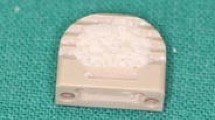Abstract
Introduction. A sheep cervical spine interbody fusion model was used to determine the effect of different carriers and growth factors on interbody bone matrix formation. The purpose of this study was to compare the efficacy and safety of combined IGF-I and TGF-β1 application with BMP-2 application in spinal fusion. Additionally, a new poly (D, L-lactide) carrier system was compared to a collagen sponge carrier.
Method. Forty sheep underwent C3/4 discectomy and fusion: group 1: titanium cage (n=8), group 2: titanium cage coated with a PDLLA carrier (n=8), group 3: titanium cage coated with a PDLLA carrier including BMP-2 (n=8), group 4: titanium cage with a collagen carrier including BMP-2 (n=8), and group 5: titanium cage coated with a PDLLA carrier including IGF-I and TGF-β1 (n=8). Blood samples, body weight, and temperature were analyzed. Radiographic scans were performed pre- and postoperatively and after 1, 2, 4, 8, and 12 weeks, respectively. At the same time points, disc space height (DSH) and intervertebral angle (IVA) were measured. After 12 weeks the animals were killed and fusion sites were evaluated using functional radiographic views in flexion and extension. Quantitative computed tomographic scans (QCT) were performed to assess bone mineral density (BMD), bone mineral content (BMC), and bony callus volume (BCV). Biomechanical testing was carried out in flexion, extension, axial rotation, and lateral bending. Range of motion (ROM), neutral zone (NZ), and elastic zone (EZ) were determined. Histomorphological and histomorphometrical analyses were performed and polychrome sequential labeling was used to determine the time frame of new bone formation.
Results. In comparison to the non-coated cages, all PDLLA-coated cages showed significantly higher values for BMD of the callus and bone volume/total volume ratio. In comparison to the cage groups (groups 1 and 2), the cage plus BMP-2 (groups 3 and 4) and the cage plus IGF-I and TGF-β1 group (group 5) demonstrated a significantly higher fusion rate in radiographic findings, a higher biomechanical stability, an advanced interbody fusion in histomorphometric analysis, and an accelerated interbody fusion on fluorochrome sequence labeling. BMP-2 application by the PDLLA carrier system (group 3) demonstrated significantly higher bony callus volume than BMP-2 application by a collagen sponge carrier (group 4). The BMP-2 group (group 3) showed significantly lower residual motion on functional radiographic evaluation and higher intervertebral bone matrix formation on fluorochrome sequence labeling at 9 weeks in comparison to the IGF-I/TGF-β1 group (group 5). In contrast, the IGF-I/TGF-β1 group (group 5) showed a significantly higher bone mineral density of the callus than the BMP-2 group (group 3).
Conclusion. PDLLA coating of cervical spine interbody fusion cages as a delivery system for growth factors was effective and safe. In comparison to the collagen sponge carrier, the new PDLLA carrier system was able to improve results of interbody bone matrix formation. Both growth factors (BMP-2 and combined IGF-I and TGF-β1) significantly accelerated results of interbody fusion. Based on these preliminary results, the combined IGF-I/TGF-β1 application yields results equivalent to BMP-2 application at an early time in anterior sheep cervical spine fusion.
Zusammenfassung
Einleitung. Wachstumsfaktoren wie BMP-2 oder BMP-7 haben einen positiven Effekt auf die intervertebrale Spondylodese. Der ideale Wachstumsfaktor und der ideale Carrier zur Applikation von Wachstumsfaktoren sind umstritten. Ziel dieser Studie war es, in einem zervikalen Schafsmodell die Wirksamkeit einer neuen Wachstumsfaktorenkombination auf die intervertebrale Spondylodese zu untersuchen. Zusätzlich sollte ein neu entwickelter biodegradierbarer Carrier aus Poly-(D,L-laktid) (PDLLA) auf seine Wirksamkeit und Sicherheit bei spinaler Applikation untersucht werden.
Material und Methode. Bei 40 Merinoschafen wurde eine intervertebrale zervikale Fusion C3/C4 mit 5 verschiedenen Stabilisierungsverfahren (n=8) durchgeführt. Gruppe 1: Harmscage; Gruppe 2: Harmscage mit PDLLA-Beschichtung; Gruppe 3: Harmscage mit einer PDLLA-Beschichtung und BMP-2; Gruppe 4: Harmscage mit Kollagen-Carrier und BMP-2; Gruppe 5: Harmscage mit einer PDLLA-Beschichtung und IGF-I und TGF-b1. Routinelaborparameter, Körpergewicht und -temperatur wurden analysiert. Prä- und postoperativ sowie nach 1, 2, 4, 8 und 12 Wochen wurden Röntgenbilder angefertigt anhand derer Intervertebral (IVA)-, Lordosewinkel und Bandscheibenraumhöhen vermessen wurden. Nach 12 Wochen wurden die Tiere getötet und funktionsradiologische Flexions/Extensions-Untersuchungen durchgeführt. Quantitative computertomographische Untersuchungen zur Bestimmung von Knochendichte (BMD), Mineralsalzgehalt (BMC) und Kallusvolumen (BCV) wurden vorgenommen. Biomechanische Testungen in Flexion/Extension, Rotation und Neigung wurden durchgeführt, um den Bewegungsumfang (ROM), die neutrale (NZ) und elastische Zone (EZ) des Bewegungssegmentes zu ermitteln. Histomorphologische, histomorphometrische Untersuchungen und polychrome Sequenzmarkierungen wurden vorgenommen.
Ergebnisse. Im Vergleich zu den unbeschichteten Cages (Gruppe 1) zeigten die beschichteten Cages (Gruppe 2) eine signifikant höhere Knochendichte des Kallus und ein signifikant höheres Knochenvolumen/Gesamtvolumen-Verhältnis. Im Vergleich zur unbeschichteten und beschichteten Cage-Gruppe (Gruppe 1 und 2) zeigte sich bei Verwendung von BMP-2 (Gruppe 3 und 4) oder IGF-I/TGF-β1 (Gruppe 5) eine höhere Fusionsrate in den radiologischen Parametern, eine höhere biomechanische Stabilität, und eine fortgeschrittene intervertebrale Fusion in den histologischen Untersuchungen. Beim Vergleich beider Carrier-Systeme mit BMP-2 (Gruppe 3 und 4) ergaben sich für den PDLLA-Carrier ein höheres Kallusvolumen und bessere histomorphometrische Parameter. Die BMP-2-Gruppe (Gruppe 3) zeigte im Vergleich zur IGF-I zu TGF-β1-Gruppe (Gruppe 5) eine geringere residuale Beweglichkeit auf Funktionsröntgenbildern und eine höhere Anzahl von Versuchstieren, bei denen sich nach 9 Wochen Knochenformationen im Intervertebralraum anhand polychromer Sequenzmarkierung nachweisen ließen. Im Gegensatz dazu zeigte die IGF-I und TGF-β1-Gruppe (Gruppe 5) eine höhere Knochendichte des Kallus.
Schlussfolgerung. Die neue PDLLA-Beschichtung ist als Carrier für Wachstumsfaktoren sicher und effektiv. Die kontinuierliche Freisetzung von Wachstumsfaktoren aus dem PDLLA-Carrier ermöglicht im Vergleich zum Kollagen-Carrier signifikant bessere Resultate. Die BMP-2- und die IGF-I/TGF-β1-Applikation mittels PDLLA-beschichteten intervertebralen Cage verbessert signifikant die Resultate der intervertebralen Spondylodese. Die neue Wachstumsfaktorenkombination IGF-I und TGF-β1 war dabei dem “golden standard” BMP-2 äquivalent.
Similar content being viewed by others
Author information
Authors and Affiliations
Additional information
Gefördert durch: MBI – Max Biedermann Institut der Steinbeis Stiftung (RS/KF-82042)
Dr. F. Kandziora Unfall- und Wiederherstellungschirurgie, Universitätsklinikum Charité der Humboldt-Universität Berlin, Campus Virchow-Klinikum, Augustenburgerplatz 1, 13353 Berlin, E-Mail: frank.kandziora@charite.de
Rights and permissions
About this article
Cite this article
Kandziora, F., Scholz, M., Pflugmacher, R. et al. Experimentelle Spondylodese der Schafshalswirbelsäule . Chirurg 73, 1025–1038 (2002). https://doi.org/10.1007/s00104-002-0490-9
Issue Date:
DOI: https://doi.org/10.1007/s00104-002-0490-9




